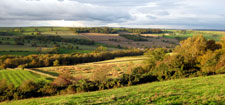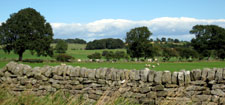Field Boundaries
Field boundaries make an important contribution to the character and biodiversity of the landscape and are one of the strongest surviving links to the farming traditions of the past. Some hedges and walls along parish boundaries, old roads and tracks date back to the medieval period and perhaps even earlier. Most were laid out in successive waves of enclosure from the late middle ages through to the nineteenth century.
For further background information on Field Boundaries visit the Landscape Assessment section.
Over much of the County the network of field boundaries has been subject to piecemeal erosion over many decades. The Durham Hedgerow Survey 1994 found that almost half of the hedges on parish and township boundaries had been lost since 1860, or survived only as relics. The Durham Hedgerow Survey 2006 estimated that 21% of the hedgerow resource had been lost since 1979.
The removal of hedges to create larger fields has had a large impact in the lowlands where the emphasis has moved to increasingly specialised arable production after a long period of mixed or pastoral farming. The decline of hedges and walls through neglect has been a less conspicuous but equally powerful force in the pastoral farmland of the uplands and upland fringes. Many hedges have also been lost to development, both built development and mineral extraction. The fragmentation of boundary networks has consequences for both the character and biodiversity of the landscape. The loss of habitat – and the loss of connectivity between habitats as the network declines – has impacts on wildlife, which increasingly depends on hedgerows for food, shelter and dispersal in intensively managed agricultural landscapes.
In recent years concern over the decline of hedgerows has lead to the development of both protective legislation (The Hedgerow Regulations 1997) and financial support for hedgerow planting and renovation in the (now obsolete) Hedgerow Incentive and Countryside Stewardship schemes. The current Environmental Stewardship Entry Level Scheme encourages appropriate cutting regimes for hedges but does not provide support for renovation works like laying and coppicing. The Higher Level Scheme is likely to be more focussed on national land management priorities and is unlikely to offer the same level of support for field boundary work as Countryside Stewardship. In County Durham, the County Durham Hedgerow Partnership was established to address the decline of hedgerows and walls and provides financial assistance through its Field Boundary Restoration Grant. The Durham Biodiversity Action Plan contains an Action Plan for hedgerows.
Issues and Objectives
Hedgerow Removal
The rate of hedgerow removal for agricultural purposes has slowed in recent years but some pressure continues in arable areas as farmers seek increases in efficiency from larger field sizes. Further pressure might be expected in the longer term and particularly if climate change brings changing patterns of land use. The removal of hedges when land is developed continues to be an issue wherever there is development pressure. Established hedges and trees can often be successfully incorporated into the design of new development and in some circumstances can be translocated where preservation is impractical. Losses of hedgerows can be mitigated in some cases by the provision of new hedges or the renovation of hedges in the locality.
Hedgerow removal is controlled by the Hedgerow Regulations 1997. The regulations have been criticised by some as being difficult to apply and failing to protect important hedges. They are currently under review. Further work is needed in the County to identify hedges of particular historical or ecological importance.
Objectives
- To encourage the protection, conservation and restoration of field boundary networks to maintain and strengthen landscape character.
- To promote awareness of the importance and value of hedges in the landscape and to provide information on the hedgerow resource to decision makers and land managers.
- To encourage and inform the reform of the Hedgerow Regulations and to guide their application.
- To encourage the retention of mature hedgerows and trees in new development together with new hedgerow planting and renovation.
- To encourage the mitigation of hedgerow loss in development through compensatory hedge planting or maintenance using Section 106 Agreements.
Neglect and Abandonment
In pastoral areas, particularly in the upland fringes where returns from land are small, hedgerow maintenance can be a low priority. Unmanaged hedgerows, reduced by grazing pressure to lines of individual thorns, are gradually supplanted by fences or abandoned altogether in favour of larger enclosures and more extensive grazing regimes. The Durham Hedgerow Survey 2006 found that 62% of the hedges surveyed showed no signs of active management, and that only 17% were in ‘favourable’ condition, with gaps along the length and in the base of the hedge being the main factors in this.
Most pastoral landscapes in the county are subject to these trends and are therefore undergoing a period of transition that will significantly affect their character in the medium to long term. Where field systems are old, or their pattern has a strong influence on the character of the landscape, this decline is of particular significance. In landscapes of more recent enclosure, a return to extensive grazing and a more open landscape may be unavoidable.
Well-managed hedgerows are cost-effective to maintain, but when management has been abandoned for some time, renovation by can be expensive. Land managers may lack the resources or the skills to carry out the work. Grant assistance for renovation was available in the past through the Hedgerow Incentive Scheme and its successor Countryside Stewardship. As Entry Level Environmental Stewardship does not provide for capital works and the Higher Level scheme is likely to be focussed on more environmentally important sites, there is currently (2007) a significant gap in funding for this kind of work. In the Durham BAP area the County Durham Hedgerow Partnership’s Field Boundary Restoration Grant is available, though it has limited resources. The Partnership produces detailed guidance on the restoration and management of field boundaries which is published on the County Council’s website.
Objectives
- To encourage the restoration of neglected hedges, particularly those of older field systems, ancient boundaries and where field patterns are an important component of landscape character.
- To promote the development of rural skills in hedgerow management.
- To secure resources for the County Durham Hedgerow Partnership’s Field Boundary Restoration Grant.
- To advise Government on the need for financial support for hedgerow renovation.
Hedgerow and Headland Management
Mechanical trimming is the commonest form of hedgerow management and in most circumstances the most cost efficient. Excessive trimming has been linked with declining vigour in hedges and greatly reduces the value of a hedge as a habitat and food resource for wildlife. In arable fields uncultivated headlands are often narrow or absent which reduces the habitat value of hedges and makes them more vulnerable to spray or fertiliser drift. In open arable landscapes hedgerows are often important refuges for wildlife and significant, if sometimes isolated, features in the landscape. Trimming over longer rotations can be more cost effective than annual trimming and create more robust and ecologically valuable hedgerows. This is now a requirement of Entry Level Environmental Stewardship. The adoption of broader field margins of permanent grass increases the value of hedges as habitat for invertebrates, including pollinating insects, birds and wildlife. The County Durham Hedgerow Partnership produces detailed guidance on the trimming of hedges which is published on the County Council’s website. The National Proficiency Tests Council (NPTC) now has a module on the environmental aspects of hedgerow maintenance in its Certificate of Competence in the Safe Use of hedge Trimmers.
Objectives
- To encourage the appropriate management of hedges to maintain and improve their vigour and value as habitat.
- To encourage the adoption of permanent grass field margins along field boundaries.
- To promote training in the environmental aspects of hedgerow maintenance and the use of suitably qualified personnel in maintenance works on the council’s land holdings.
Hedgerow and Field Trees
Boundary trees are important feature of much of the lowland and upland fringe landscape and in many cases are veteran survivors of a time when they where more highly valued for their timber or for shading livestock. A high proportion of hedgerow trees are mature and there is little positive recruitment of new trees to replace those that are lost to sustain their overall numbers. Boundary trees are vulnerable to damage from close cultivation, from fencing works and mechanical hedge trimming. Trees may be removed in arable areas to reduce crop shading or increase field size.
Objectives
- To support the recording and mapping of ancient and veteran trees.
- To encourage the protection and careful management of mature hedgerow trees.
- To encourage the planting or recruitment of new hedgerow and boundary trees in landscapes where they are characteristic.
Dry Stone Walls
Dry stone walls are a distinctive feature of the County’s upland and upland fringe landscapes. In places the network is in generally good repair and particularly in the Pennine Dales Environmentally Sensitive Areas (ESA) where financial assistance has been available for restoration. Elsewhere the situation is more varied. In the marginal land of the upland fringes many walls are derelict or in poor repair and are often abandoned, replaced by fences, or removed as a source of building stone. Roadside walls in particular are vulnerable to damage and theft. Grant assistance for repairing walls was available in the past through ESA agreements and Countryside Stewardship. Some assistance will continue to be available in Environmental Stewardship Higher Level schemes but only for whole farm schemes within the AONB. There is likely to be a significant gap in funding for this kind of work elsewhere. A new training scheme for apprentice wallers was launched in 2007 by the North Pennines AONB Partnership and BTCV. This should go some way to addressing the skills shortage in dry stone walling in the area as a whole.
Objectives
- To encourage the restoration of dry stone walls and particularly where they are part of a wider network or make a strong individual contribution to local landscape character.
- To support the development of rural skills in dry stone walling.
- To advise Government on the need for financial support for walling renovation.
New Hedges in the Landscape
There is increasing interest in planting new hedges both amongst farmers, conservation organisations and developers. Priorities for new planting include areas where hedgerow networks have been severely disrupted in the past – for example in areas of intensive arable farmland and restored mineral workings – and in connecting isolated habitats such as semi-natural woodlands, field ponds and species rich grasslands. The County Durham Hedgerow Partnership produces detailed guidance on hedge planting which is published on the County Council’s website.
Objectives
- To encourage the planting of new hedgerows of an appropriate character where they can bring particular benefits in restoring landscape character and enhancing biodiversity.
Further Information
- For further information on the the Field Boundary Restoration Grants visit the Durham Hedgerow Partnership pages.
- For information on Environmental Stewardship visit Natural England‘s website.



